Solar nebula - Study guides, Class notes & Summaries
Looking for the best study guides, study notes and summaries about Solar nebula? On this page you'll find 216 study documents about Solar nebula.
Page 3 out of 216 results
Sort by
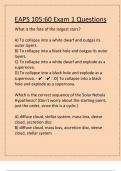
-
EAPS 105:60 Exam 1 Questions With 100% Correct Answers|23 Pages
- Exam (elaborations) • 23 pages • 2024
- Available in package deal
-
- $8.49
- + learn more
What is the fate of the largest stars? A) To collapse into a white dwarf and outgas its outer layers. B) To collapse into a black hole and outgas its outer layers. C) To collapse into a white dwarf and explode as a supernova. D) To collapse into a black hole and explode as a supernova. - ️️D) To collapse into a black hole and explode as a supernova. Which is the correct sequence of the Solar Nebula Hypothesis? (Don't worry about the starting point, just the order, since this is a...
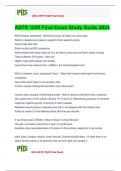
-
ASTR 1020 Final Exam Study Guide 2024
- Exam (elaborations) • 18 pages • 2024
-
- $14.49
- + learn more
White dwarfs: properties - Remaining cores of dead, low mass stars Electron degeneracy pressure supports them against gravity Slowly fade with time Sirius and its hot WD companion White dwarfs with same mass as Sun are about same size as Earth; slowly cooling Typical density 10^6 gram / cubic cm Higher mass white dwarfs are smaller Cannot be more massive than 1.4MSun, the Chandrasekhar limit WDs in binaries: nova, supernova Type I - Mass falls toward white dwarf from binary companion ...
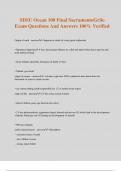
-
SDSU Ocean 100 Final SacramentoGrilo Exam Questions And Answers 100% Verified
- Exam (elaborations) • 20 pages • 2024
- Available in package deal
-
- $13.49
- + learn more
SDSU Ocean 100 Final SacramentoGrilo Exam Questions And Answers 100% Verified Origin of earth - answer• Supernova: death of a star (great explosion) • Supernova happened 4.6 bya, dust and gas flattens to a disk and spins faster due to gravity and solar nebula formed. • Solar Nebula: describes formation of Earth 4.5 bya • Nebula: gas cloud origin of oceans - answer• volcanic explosion, H2O condensed and rained down for thousands of years to create oceans • icy comets hitting ...
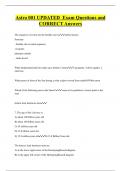
-
Astro 001 UPDATED Exam Questions and CORRECT Answers
- Exam (elaborations) • 20 pages • 2024
-
- $9.49
- + learn more
The sequence of events for the Sunlike star isstellar nursery Protostar , Sunlike star on main sequence, red giant, planetary nebula , white dwarf What fundamental particles make up a helium 3 atom5 up quarks, 4 down quarks, 2 electrons What passes in front of the Sun during a solar eclipse viewed from earththe moon Which of the following moves the fastest?venus at its perihelon ( closest point to the sun)

-
EAPS 105|71 Exam 1 Review Questions Well Anwered|2025
- Exam (elaborations) • 7 pages • 2024
- Available in package deal
-
- $7.99
- + learn more
Why the gas giants had to form within 3-10 million years from the birth of the Sun - ️️they had to attract hydrogen and helium gases before these were blown away by the solar wind Why the giant planets have faster spin rates than terrestrial planets - ️️because they are more massive Why the interiors of large asteroids and planets are very hot inside - ️️when they get big enough they heat up inside due to the heat of accretion and radioactive decay, causing the interior to melt Wh...
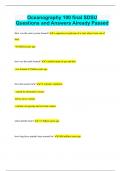
-
Oceanography 100 final SDSU Questions and Answers Already Passed
- Exam (elaborations) • 57 pages • 2024
- Available in package deal
-
- $11.99
- + learn more
Oceanography 100 final SDSU Questions and Answers Already Passed How was the solar system formed? -a supernova (explosion of a start when it runs out of fuel) -4.6 billion years ago how was the earth formed? -a nebula made of gas and dust -was formed 4.5 billion years ago how did oceans form? -A volcanic expulsion - rained for thousands of years -hit by an icy comets -volcanic out gassing and ice from comets when did life form? -3.7 billion years ago how long have ani...
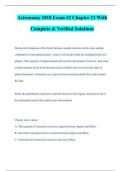
-
Astronomy 1010 Exam #2 Chapter 12 With Complete & Verified Solutions
- Exam (elaborations) • 12 pages • 2023
-
- $10.49
- + learn more
During the formation of the Solar System, smaller particles in the solar nebula combined to form planetesimals, some of which provided the building blocks for planets. The majority of planetesimals did not become planets, however, and some of them remain in the Solar System today as debris left over from the time of planet formation. Asteroids are a special class of planetesimals that orbit around the Sun. Study the distribution of known asteroids shown in this figure, and choose all of t...
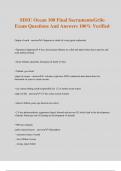
-
SDSU Ocean 100 Final SacramentoGrilo Exam Questions And Answers 100% Verified
- Exam (elaborations) • 20 pages • 2024
- Available in package deal
-
- $13.49
- + learn more
SDSU Ocean 100 Final SacramentoGrilo Exam Questions And Answers 100% Verified Origin of earth - answer• Supernova: death of a star (great explosion) • Supernova happened 4.6 bya, dust and gas flattens to a disk and spins faster due to gravity and solar nebula formed. • Solar Nebula: describes formation of Earth 4.5 bya • Nebula: gas cloud origin of oceans - answer• volcanic explosion, H2O condensed and rained down for thousands of years to create oceans • icy comets hitting ...
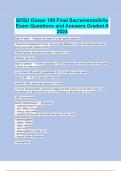
-
SDSU Ocean 100 Final SacramentoGrilo Exam Questions and Answers Graded A 2024
- Exam (elaborations) • 16 pages • 2024
- Available in package deal
-
- $13.49
- + learn more
origin of earth - • Supernova: death of a star (great explosion) • Supernova happened 4.6 bya, dust and gas flattens to a disk and spins faster due to gravity and solar nebula formed. • Solar Nebula: describes formation of Earth 4.5 bya • Nebula: gas cloud origin of oceans - • volcanic explosion, H2O condensed and rained down for thousands of years to create oceans • icy comets hitting earth (responsible for 1/2 of earths ocean water) origin of life - • 4.5 bya ...
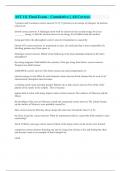
-
AST 111 Final Exam – Cumulative || All Correct.
- Exam (elaborations) • 13 pages • 2024
- Available in package deal
-
- $11.49
- + learn more
7 protons and 8 neutrons correct answers N-15 (7 protons) is an isotope of nitrogen. Its nucleus consists of: absorb correct answers A Hydrogen atom with its electron in the second energy level can ________ energy so that the electron moves to an energy level farther from the nucleus. rising gas below the photosphere correct answers Granulation is caused by: Ozone (O3) correct answers As mentioned in class, the molecule that is most responsible for blocking gamma-rays from space is: ...

How much did you already spend on Stuvia? Imagine there are plenty more of you out there paying for study notes, but this time YOU are the seller. Ka-ching! Discover all about earning on Stuvia


